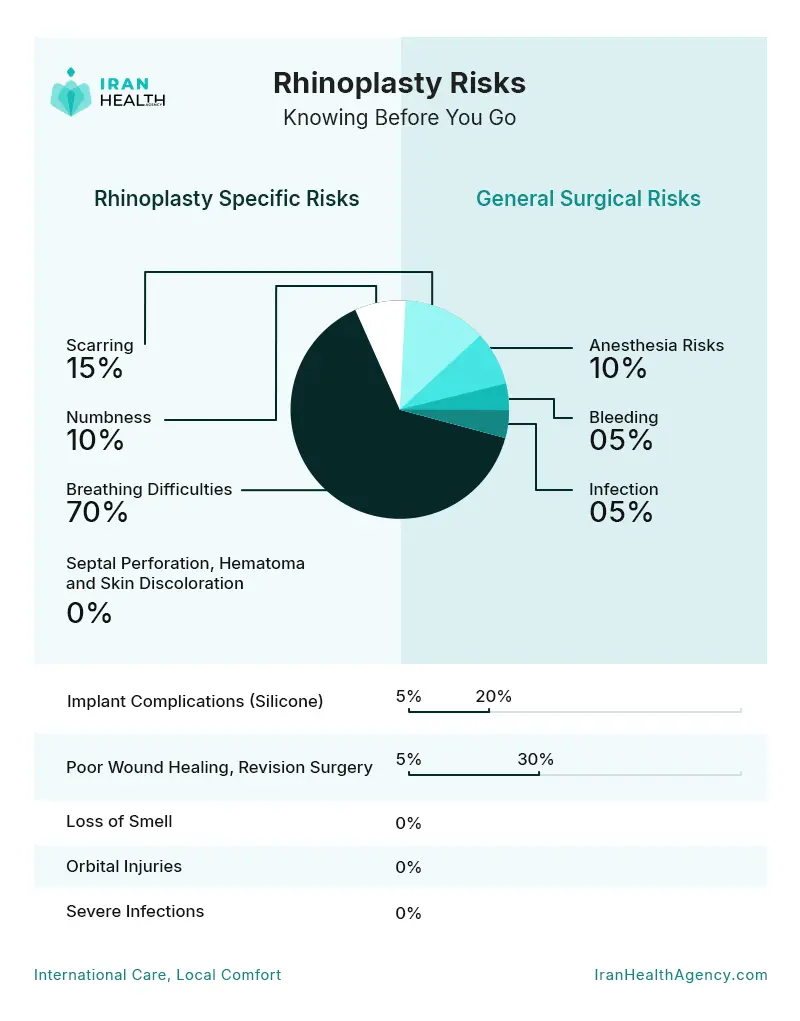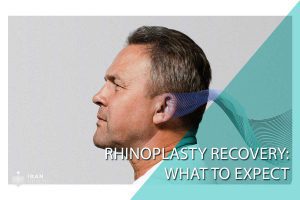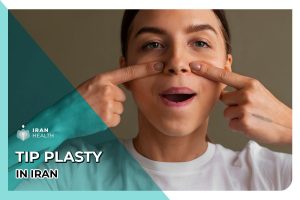But don’t worry! All you need to do is research to ensure you and your surgeon agree on what to expect and what might happen.
What are the complications of rhinoplasty?

As we said above, rhinoplasty has several dangers and possible problems, even if it can produce notable functional and aesthetic gains. Patients who wish to make an educated choice should have a long discussion with their surgeon about these.
All these risks and potential complications can be broadly categorized into general surgical risks, specific complications related to the procedure, and long-term issues. Here is a detailed overview:
General Surgical Risks
- Anesthesia Risks: These include reactions to the anesthesia used during the procedure, ranging from mild to severe.
- Infection: It’s possible to get an infection post-op, which needs antibiotics or more surgery.
- Bleeding: Heavy bleeding from the surgical site is a potential risk.
Specific difficulties:
- Scarring: Scarring can occur at the base of the nose or around the incision sites. Keloids and hypertrophic scars, which are raised and thickened, may form and can be itchy or unsightly.
- Numbness and Altered Sensation: Patients may experience numbness or altered sensation in the nose and upper front teeth.
- Breathing Difficulties: Many revision rhinoplasty patients report breathing disturbances, which can be due to structural changes or scarring.
- Nasal Septal Perforation: A hole in the nasal septum is a rare but severe complication that may require further surgical treatment.
- Hematoma: A large blood clot forming beneath an incision site may require drainage.
- Skin Discoloration and Swelling: Skin under the eyes may darken, and swelling can persist for an extended period.
Implant Complications: If implants are used, there is a risk of infection, extrusion (implant poking out), and distortion. Silicone implants, in particular, have a complication rate of 5-20%.
Long-term and uncommon Complications
- Poor Wound Healing: Slow healing can be influenced by factors such as smoking or diabetes.
- Revision Surgery: Unsatisfactory nasal appearance may necessitate additional surgery.
- Loss of Smell: In rare cases, smell may be impaired or lost.
- Orbital Injuries: Osteotomies (bone cutting) can cause injuries to the orbital region, potentially leading to necrosis of the eyelids or blindness.
- Severe Infections: Life-threatening infections like toxic shock syndrome are rare but possible, especially when combined with sinus surgery.
- Psychological Impact: Dissatisfaction with the aesthetic outcome can lead to psychological distress and even legal disputes.
Read more: How long does the pain last after rhinoplasty?
Recovery Considerations
- Swelling and Bruising: Initial swelling subsides within a few weeks, but it may take up to a year for the nose to fully refine to its final shape.
- Activity Restrictions: Patients are advised to avoid strenuous activities, heavy lifting, and sports for several weeks to months post-surgery.
Despite the above data, you may want to read the following: Is nose Surgery Painful?
When patients are informed about all these risks, they ask how common they are (in what percentage can these risks happen?). Let’s discuss it.
How common are rhinoplasty complications?
Even though rhinoplasty may have some possible side effects, significant problems are uncommon. We always recommend one thing: Patients should talk to their operators about these risks to determine how likely each one is and what it means for them.
But to make your decision smoother, we provide you with some data based on some reputable sources.
Remember that the risk of complications after rhinoplasty can vary greatly depending on the source and the specific procedures. The rates below are based on certain studies and may not accurately reflect the general rate of complications after rhinoplasty.
Major Complications
- Significant Complications: The incidence of major complications in rhinoplasty is relatively low. A study found that major complications occurred in only 0.7% of patients. This is significantly lower than the complication rate for other cosmetic procedures, which is 2.0%.
Specific Complications
- Bleeding: Severe bleeding requiring quick attention occurs in less than 1 in 500 cases (0.2%). Epistaxis (nosebleeds) is the most common complication, with severe bleeding occurring in less than 1% of patients.
- Infection: Postoperative infections occur in about 1% of cases. Most infections can be treated with antibiotics, but in some cases, additional procedures may be required.
- Septal Perforation: This is a rare complication but can occur, leading to a hole in the nasal septum.
- Skin Discoloration: Skin discoloration, particularly around the tip of the nose and nostrils, is uncommon but can occur, especially in patients with a history of multiple surgeries or filler use.
- Altered Sense of Smell or Taste: This is very rare, occurring in much less than 1% of cases.
- Numbness and Altered Sensation: Numbness or altered sensation in the nose and upper front teeth can occur but is generally temporary.
- Breathing Difficulties: Breathing disturbances are reported in up to 70% of revision-rhinoplasty patients.
- Implant Complications: Silicone implants have a complication rate of 5-20%, including risks of infection and extrusion.
Long-term and Rare Complications
- Revision Surgery: The need for revision surgery is a significant risk, with rates ranging from 5% to 30% depending on factors such as patient-surgeon communication and the surgeon’s experience.
- Severe Infections: Life-threatening infections like toxic shock syndrome are rare but possible, especially when combined with sinus surgery.
- Orbital Injuries: Injuries to the orbital region, including necrosis of the eyelids and blindness, are infrequent but serious complications.
Summary of Cases and Rates
- Major Complications: 0.7%
- Severe Bleeding: <0.2%
- Infection: 1%
- Septal Perforation: Rare
- Skin Discoloration: Rare
- Altered Sense of Smell or Taste: <1%
- Breathing Difficulties: Up to 70% in revision cases
- Implant Complications: 5-20% for silicone implants
- Revision Surgery: 5-30%
What risks can happen during rhinoplasty (for example, anesthesia in the operating room)?
In some cases, patients are very concerned about going to the surgical room and are afraid; therefore, we decided to discuss these specific concerns separately.
Some risks in the operating room are:
- The general risks of anesthesia are the same as those of any surgery. For example, you could get sick or have an allergic reaction. Your doctor will discuss your health problems and set up the anesthesia to help reduce them.
- Bleeding and infections are rare but can happen. Your surgeon will minimize them, and you will be given advice on how to avoid getting an infection at home.
- Breathing Problems: In rare cases, the surgery could make it difficult for you to breathe correctly. Your expert will carefully examine your body to lower this risk as much as possible.
For more information, please read: is the breathing problem normal after rhinoplasty?
- Feeling numb: Feeling numb around the nose for a short time is common, but feeling numb for a long time is less likely.
- Unsatisfactory Outcome: The results may sometimes differ from what you hoped for. This risk is lower if you talk to your surgeon about what you want to happen. There are times when revision surgery might be a good idea.
We think you need to hear something reassuring from an experienced doctor to ease your anxiety of fear of surgery so;
A talk with Patients or candidates for rhinoplasty:
According to doctor Ahmadi of IHA’s plastic surgery department:
Surgeons and anesthesiologists with a lot of experience do everything they can to ensure that rhinoplasty surgery, specially rhinoplasty in iran goes smoothly and safely. Being aware of possible risks is important, but it’s also important to remember that they only happen sometimes and are usually easy to deal with.
Surgeons and anesthesiologists are ready for anything that might happen in the operating room.
For instance, they do things to lower the risk of side effects like sore throats, sickness, and vomiting due to anesthesia. They can also handle more major problems that can happen because of anesthesia, even though they don’t happen very often.
Surgeons use advanced techniques and careful planning to ensure the process goes smoothly and safely, reducing the chance of bleeding. They also have the tools and knowledge to act quickly and successfully if heavy bleeding is unlikely.
In surgical facilities, infections are rare, and doctors take great care to prevent them. They are trained to spot and treat any possible infections quickly, giving patients the best chance of a good result.
As part of the process, surgeons are careful not to hurt nearby structures like the eyes, nerves, and teeth. Even though these risks are minimal, patients can be sure that doctors will give them the best care and attention to detail possible.
The surgeon and the patient can work together to get a good result if they know the possible risks and take steps to reduce them. The goal of rhinoplasty surgery is to make the patient feel safe, comfortable and changed in a way that goes beyond their hopes.
How can patients minimize the risk of complications during rhinoplasty?
It needs to be said again, having plastic surgery is a very very personal choice so if you decide to be more beautiful, minimizing the risks all depends on you; to reduce the risks of your decisions do the below tips:
- Talk to a Qualified Surgeon first: A face plastic surgeon who is board-certified can look at your case and talk about:
- What you want to happen (your desired outcome)
- Your health (medical)history
- The risks that are unique to you
- Expectations that are reasonable for the surgery and healing
- How to Pick the Best Surgeon: The American Board of Facial Plastic and Reconstructive Surgery (https://www.abfprs.org/) allows you to verify a surgeon’s certification.
- Look for surgeons with experience in rhinoplasty and before-and-after photos of their work.
- Read patient reviews to understand their bedside manner and communication style.
- Make an Informed Decision: Once you’ve talked to a surgeon and learned about the risks and possible results, you can decide if rhinoplasty is worth the money. You don’t have to rush into surgery. Allow yourself enough time to feel at ease and sure about your choice.
- Open lines of dialogue: Tell the truth about your medical background and what you want. The doctor will talk about the risks and what to expect while you are healing.
- Good habits(Lifestyle): Do not smoke for a long time (at least 6 weeks), as it slows down the healing process. Fruits and veggies are good for you; eating them regularly will help your body heal.
- Carefully follow the directions: Some of these are proper wound cleaning, keeping the head elevated after surgery, and not doing too much physical exercise.
- Pay attention to your body: Do not be afraid to call your surgeon if you are in a lot of pain, swelling, or bleeding.
Beyond Risks: Cost Considerations for Informed Decisions
Even though money doesn’t directly affect risks, rhinoplasty surgery is costly. Generally, high-experience physicians have high salaries. Mid-level doctors may be able to get them for a lower price, but this appears maybe to be a bad result. You need to look out for good doctors at reasonable prices.
Medical tourism companies specializing in cosmetic surgery for the face can help you understand these prices and maybe even find cheaper options while still providing you with the best surgeons(the skilled ones).
Now, talking about money’s effect on rhinoplasty, you may be interested in this topic, too: effects of rhinoplasty
IranHealthAgency: Your Trusted Partner for Safe and Affordable Rhinoplasty
Considering Medical Tourism(going to the other countries) for Rhinoplasty? IranHealthAgency can help you find skilled surgeons and possibly ways to save money on your rhinoplasty.
We help you research for good doctors considering all the aspects of verified doctors such as their experience, the success rate of their outcomes, and booking the free consultation with no waiting time, talking to get a discount, and all your nursing aftercare to ignore all these risks for nose jobs before and after surgery.
Contact us right away to get a free consultation and discuss your choices for safe and effective treatment.
Also, this company provides other services such as IVF in Iran, which you can learn more about by clicking on the link below: IVF in Iran
References:
- realself.com
drkimfacialplastics.com
ncbi.nlm.nih.gov
plasticsurgery.org
researchgate.net
journals.sagepub.com
researchgate.net
plasticsurgery.org



